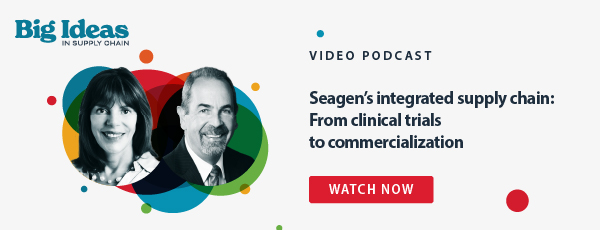Supply chains play a critical role in any organization, but for biopharma company Pfizer (formerly Seagen), robust supply and demand planning processes could mean the difference between life and death. Pfizer has been manufacturing Antibody Drug Conjugate (ADC) technology for 25 years, an innovative medicine akin to chemotherapy that selectively kills cancer cells. As many doctors and patients around the world rely on having a continuous supply of this life-changing medicine, the role of advanced planning is at the forefront of Pfizer’s supply chain model.
Spearheading their efforts is Elisabeth Kaszas, VP of Global Supply Operations at Pfizer, who has over 30 years of experience working in life sciences and biopharma companies. She is joined by Allen Jacques, Industry Thought Leader at Kinaxis, in this episode of Big Ideas in Supply Chain to discuss the impressive work she has done transforming Pfizer’s supply chain during a period of rapid growth. They deliver valuable insights on the importance of robust demand planning, the need for seamless data exchanges within the biopharma industry to reduce lead times, and the unique, evolving challenges of biopharma supply chains.
Here are a few key takeaways from their conversation.
Transforming Pfizer’s supply chain
Pfizer was in the midst of launching three major products when Elisabeth joined the company. There was a tremendous amount of growth associated with the launch of so many products in a short period of time, creating many opportunities to scale up Pfizer’s supply chain. “As the company grew fast, there was an opportunity to look at how to scale up the operations, to make sure that we understood the demand signals as quickly as feasible and translate them into production plans, and supply plans, and distribution capabilities that allowed us to launch the product,” Elisabeth says.
As the company continued to grow, Elisabeth knew they needed to remain agile. To do this, it became important to create more robust roles, responsibilities, and processes to ensure they would be able to sustain the volume and complexity of products they were delivering globally. “I went to where a lot of supply chain leaders would go,” she says. “I ensured that we would have a very robust demand planning process with early signals and rapid feedback loops to ensure that the market signals would translate into changes to our pipelines as rapidly and as efficiently as possible.”
In addition to clarifying roles and responsibilities while developing robust planning systems, Elisabeth also knew it was important to create a forum where new inventory and processes could be reviewed and agreed upon by executive management teams. To do this, she implemented an integrated business planning (IBP) process to identify significant changes that could affect supply and demand. “I must say that the IBP journey that we started at Pfizer has proven to be quite successful. There’s better end-to-end visibility and we are able to understand when decisions need to be made cross-functionally, and not just within operations but also when it comes to investments in terms of supply, production, inventory, and so forth,” Elisabeth explains.
Navigating lead times
Elisabeth says the key to linking commercial and clinical signals to manufacturing, distribution, and logistics is having a supply chain with strong demand and supply planning processes. She applies this well-rounded approach to inform demand and supply signals when forecasting across multiple countries.
Pfizer works with their Global Insights division to understand the patient demographics of the markets they’re entering. They provide a detailed account of demand based on multiple layers of patient SKUs that might benefit from Pfizer’s innovative medicines. From there, they’re able to develop supply scenarios with the help of their executive team to determine what demand level they need to supply. This process often requires significant investment and long lead times. Elizabeth explains, “It’s not unique to BioPharma but we deal with very long lead times. It takes many weeks to produce monoclonal antibodies. It takes many weeks to conjugate the monoclonal antibody with the drug linker. […] As fast as we all want to be, it still takes months to produce lifesaving therapies.”
To combat these long lead times, Pfizer uses safety stock buffers to maintain a small level of inventory. Elisabeth also states that she’s seen a lot of improvements over the past 20 years with the help of analytics and digital tools to gain deeper insights of their end-to-end times. “We have the ability to understand where we have the most inventory or where it takes us the longest time and we’ve seen some value in stream mapping,” Elisabeth says. “We’ve seen continuous improvement on how we can reduce the disposition cycle time from weeks to days and reduce the prep time prior to manufacturing. […] I think it's a cross-functional effort across operations to reduce these lead times.”
The future of biopharma supply chains
When looking towards the future, Elisabeth says that the biopharma industry could benefit from standardizing the way data is transferred. “BioPharma companies, contract manufacturing organizations, third party logistics providers, raw materials suppliers – I mean, we all have interfaces, we all know the different technologies we can use to make these interfaces robust, but when you think about it, we are lacking those highways to allow us to exchange data with all the security measures,” Elisabeth indicates.
Biopharma has reached a point where significant efforts should be made to collaborate and share data with ease. Since most biopharma organizations use the same 3PL, CMOs, or raw material suppliers, Elisabeth says it would be more efficient to not have to reset interfaces consistently.
Elisabeth also reiterates the importance of reducing lead times in an industry as critical as biopharma where patients rely on life-saving treatments. “How long does it take to bring innovative medicine to patients? We, within supply chain, we need to play a role in that space.”
To hear more about Pfizer’s integrated supply chain from Elisabeth Kaszas and Allen Jacques, watch the full video podcast here:
To dive into more great supply chain thought leadership content, check out some of our recent Big Ideas in Supply Chain podcasts:
Transforming your supply chain: The Crawl-Walk-Run method, with Jamieson Wellness
How operationalizing supply chain sustainability drives business






